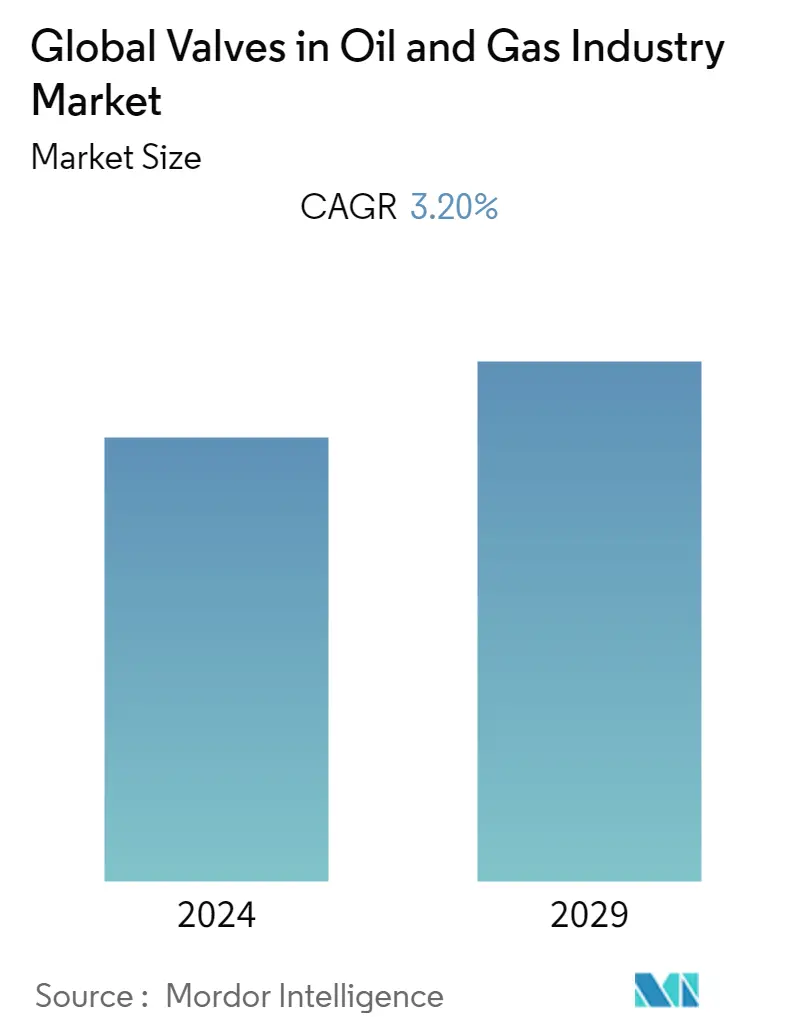Market Size of Global Valves in Oil and Gas Industry Industry

| Study Period | 2019 - 2029 |
| Base Year For Estimation | 2023 |
| CAGR | 3.20 % |
| Fastest Growing Market | Asia-Pacific |
| Largest Market | Middle East and Africa |
| Market Concentration | Medium |
Major Players
*Disclaimer: Major Players sorted in no particular order |
Valves in Oil and Gas Market Analysis
Global Valves in the Oil and Gas Industry Market are expected to register a CAGR of 3.2% over the forecast period (2022 - 2027). Advancements in technology have shaped innovative solutions that can improve process plants to become increasingly more efficient through streamlining of their operations. As Oil and gas industry requirements evolve and change, suppliers of control valves and valve automation solutions are expected to continue developing products and processes that address these new challenges.
- The growth of the valves market is driven by factors such as the increasing need for wireless/remote infrastructure to monitor equipment in various plants, along with an augmented focus on technology advancements propelling the application of smart valves, especially in the industrial sector. Major industries such as oil and gas are moving toward valve technology with embedded processors and networking capability to work alongside sophisticated monitoring technology coordinated through a central control station.
- Moreover, major countries in the Middle East have increased focus on the renovation of existing refineries and also the expansion of their oil refineries to meet the growing demand for crude oil. This is expected to result in increased investments in the pipeline and infrastructural development, which is expected to augment the demand for valves over the forecast period.
- The new valves designed in the market for the oil and gas industry comply with ASME and ASTM material standards for chemical strength across the globe. In addition, the valves also comply with ASME B1.20.1, ASME B16.11, and ASME B16.34, which are accepted across the globe. The standards ensure the quality and longevity of the valves life for the Oil and Gas industries.
- However, one of the major challenges for valves is the availability of alternate valves. For instance, globe, butterfly, and check valves are considered alternatives to gate valves as these valves control and regulate the flow of gasses by also handling high temperatures.
- Additionally, according to the International Energy Agency (IEA), in the OECD countries, the oil price was reduced by 40.6% from March to April 2020, nurturing concerns for oil and gas firms. Therefore, during the spread of COVID-19, companies in the oil and gas sector started experimenting with contemporary technologies and industrial automation to increase efficiency and revenue. This brought a positive impact on the market studied during the pandemic.
Valves in Oil and Gas Industry Segmentation
Valves are mechanical devices that open, close, or partially obstruct passageways to regulate the flow of liquid or gas within a system. The valves are also used to isolate, control and protect the equipment used in the oil and gas industries. Additionally, the valves direct and guide the refining of the crude oil.
The scope of the study focuses on the market analysis of Valves for Oil and gas industry across the globe, and market sizing encompasses the revenue generated through valves sold by various market players to Oil and gas industry. The study also tracks the key market parameters, underlying growth influencers, and major vendors operating in the industry, which supports the market estimations and growth rates over the forecast period.
| By Valve | |
| Ball Valve | |
| Butterfly Valve | |
| Gate/Globe/Check Valve | |
| Control Valve |
| By Geography | |
| North America | |
| Europe | |
| Asia | |
| Latin America | |
| Middle East and Africa |
Global Valves in Oil and Gas Industry Market Size Summary
The oil and gas valves market is experiencing a steady growth trajectory, driven by technological advancements and the increasing need for efficient infrastructure. As the industry evolves, there is a growing demand for control valves and automation solutions that can meet new challenges. The focus on smart valves, particularly in the industrial sector, is propelling the market forward. Major regions, especially the Middle East, are investing in the renovation and expansion of refineries to meet the rising demand for crude oil, which in turn is boosting the demand for valves. Compliance with international standards such as ASME and ASTM ensures the quality and durability of these valves, supporting their widespread adoption in the oil and gas sector.
The market is characterized by innovation and strategic partnerships, with companies like Dixon and AMPO POYAM VALVES leading the way in introducing new products and securing significant contracts. The introduction of advanced valve technologies, such as the 2-piece stainless steel ball valves, is reducing the need for frequent replacements and service investments. Additionally, ongoing and upcoming projects in regions like Africa and the Middle East are expected to further drive demand. The market remains moderately fragmented, offering substantial growth opportunities for valve manufacturers as industrial automation and Industry 4.0 concepts gain traction alongside expanding oil and gas production capacities worldwide.
Global Valves in Oil and Gas Industry Market Size - Table of Contents
-
1. MARKET INSIGHTS
-
1.1 Market Overview
-
1.2 Industry Attractiveness - Porter's Five Forces Analysis
-
1.2.1 Bargaining Power of Suppliers
-
1.2.2 Bargaining Power of Consumers
-
1.2.3 Threat of New Entrants
-
1.2.4 Intensity of Competitive Rivalry
-
1.2.5 Threat of Substitutes
-
-
1.3 Assessment of the Impact of COVID-19 on the Industry
-
-
2. MARKET SEGMENTATION
-
2.1 By Valve
-
2.1.1 Ball Valve
-
2.1.2 Butterfly Valve
-
2.1.3 Gate/Globe/Check Valve
-
2.1.4 Control Valve
-
-
2.2 By Geography
-
2.2.1 North America
-
2.2.2 Europe
-
2.2.3 Asia
-
2.2.4 Latin America
-
2.2.5 Middle East and Africa
-
-
Global Valves in Oil and Gas Industry Market Size FAQs
What is the current Global Valves in Oil and Gas Industry Market size?
The Global Valves in Oil and Gas Industry Market is projected to register a CAGR of 3.20% during the forecast period (2024-2029)
Who are the key players in Global Valves in Oil and Gas Industry Market?
Emerson Electric Co., Danfoss A/S , Dwyer Instruments LTD, Schlumberger Limited and Flowserve Corporation are the major companies operating in the Global Valves in Oil and Gas Industry Market.

